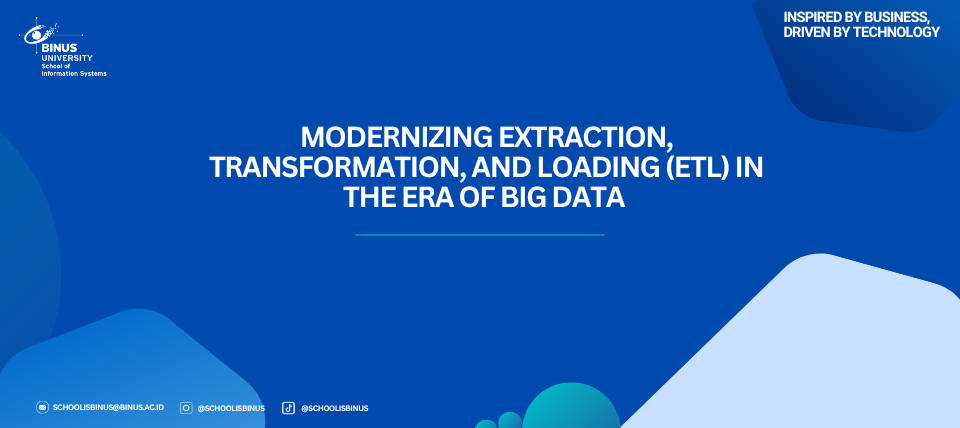Modernizing Extraction, Transformation, and Loading (ETL) in the Era of Big Data

Introduction
Extraction, Transformation, and Loading (ETL) form the backbone of data warehouse (DW) and analytics systems. The ETL process extracts data from multiple heterogeneous sources, transforms it into a consistent and analytical format, and loads it into a target warehouse or data repository. According to Bhatia (2019), ETL ensures that data stored in warehouses is clean, reliable, and consistent with organizational goals.
In recent years, the traditional ETL pipeline has evolved to accommodate the needs of big data, cloud computing, and real-time analytics. The classical batch-oriented ETL is gradually being replaced by more agile architectures such as ELT (Extract, Load, Transform) and stream-based pipelines, which leverage the computational power of modern data platforms.
- The Classical ETL Framework
In its conventional form, ETL consists of three major stages (Bhatia, 2019):
- Extraction: Data is collected from operational systems, flat files, APIs, or external data sources.
- Transformation: The extracted data is cleaned, standardized, aggregated, and integrated into a unified schema.
- Loading: The transformed data is then stored in a target database, typically a data warehouse, for reporting and analytics.
The traditional ETL process was designed for structured, relational environments. It assumes data stability and well-defined schemas, which fit perfectly within enterprise data warehouses (EDWs) of the early 2000s. However, as data volume, variety, and velocity have increased, this model began facing limitations in scalability and adaptability (Dhaouadi et al., 2022).
- The Shift Toward ELT and Stream Processing
Modern data architectures especially cloud-based and big data systems have shifted from ETL to ELT (Extract, Load, Transform). In this model, data is first extracted and loaded directly into scalable storage (like data lakes), and transformations occur afterward using distributed processing tools such as Spark, Snowflake, or BigQuery.
This change enhances flexibility and performance because the transformation workload can now be parallelized and executed closer to the data (Bimonte et al., 2023). Additionally, ELT supports schema-on-read, allowing analysts to define transformations dynamically during query time.
The rise of real-time and stream-based ETL has also revolutionized data processing. Instead of batch operations, data pipelines now integrate tools like Apache Kafka, Flink, and Debezium to continuously process event streams. This real-time approach enables immediate insights, which are crucial for sectors like finance, IoT, and digital marketing (Yüksel & Kaya, 2021).
- Automation and Metadata-Driven ETL
As data ecosystems grow more complex, managing ETL manually becomes unsustainable. New frameworks emphasize metadata-driven and automated ETL, where workflows are dynamically generated based on schema metadata and business rules (Helskyaho et al., 2024).
Automation improves data governance and lineage tracking critical elements for compliance with data regulations such as GDPR and ISO/IEC 27001. Furthermore, metadata-driven ETL supports self-adapting pipelines that automatically adjust to schema changes, reducing the risk of pipeline failure and maintenance costs.
- Challenges and Future Trends
Despite technological advancements, ETL pipelines still face key challenges:
- Data Quality & Consistency: Inconsistent data sources require continuous validation and cleansing.
- Scalability: Handling petabytes of structured and unstructured data demands elastic infrastructure.
- Latency: As analytics move toward real-time, ETL must minimize delays without sacrificing reliability.
Emerging solutions combine ETL and machine learning, introducing ETL pipelines enhanced with AI-based anomaly detection and data profiling (Gupta et al., 2024). These “intelligent ETL” systems proactively detect quality issues and optimize resource usage automatically.
Bhatia (2019) notes that while technology changes, the conceptual principles of ETL remain constant, ensuring data reliability, consistency, and integration across diverse environments. Modern ETL simply extends these foundations to meet the scale and complexity of contemporary data systems.
References
Bhatia, P. (2019). Data Mining and Data Warehousing: Principles and Practical Techniques. Cambridge University Press.
Bimonte, S., Gallinucci, E., Marcel, P., & Rizzi, S. (2023). Logical design of multi-model data warehouses. Knowledge and Information Systems, 65, 1067–1103. https://doi.org/10.1007/s10115-022-01788-0
Dhaouadi, A., Bousselmi, K., Gammoudi, M. M., Monnet, S., & Hammoudi, S. (2022). Data warehousing process modeling from classical approaches to new trends: Main features and comparisons. Data, 7(8), 113. https://doi.org/10.3390/data7080113
Gupta, S., Sharma, R., & Kumar, P. (2024). AI-driven automation for data integration: Enhancing ETL processes in modern analytics systems. Journal of Big Data Engineering, 10(2), 215–230.
Helskyaho, H., Ruotsalainen, L., & Männistö, T. (2024). Defining data model quality metrics for Data Vault 2.0 model evaluation. Inventions, 9(1), 21. https://doi.org/10.3390/inventions9010021
Yüksel, E., & Kaya, A. (2021). Stream-based ETL for real-time data warehouse environments. Procedia Computer Science, 181, 454–461. https://doi.org/10.1016/j.procs.2021.01.193

